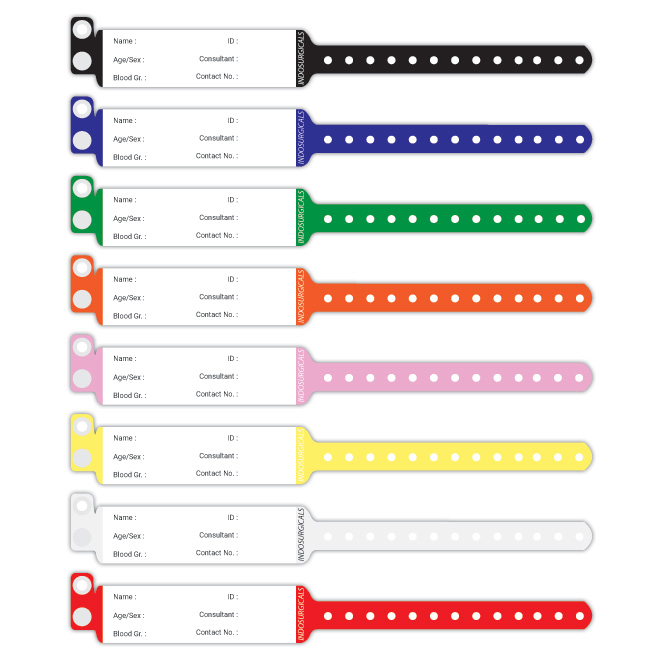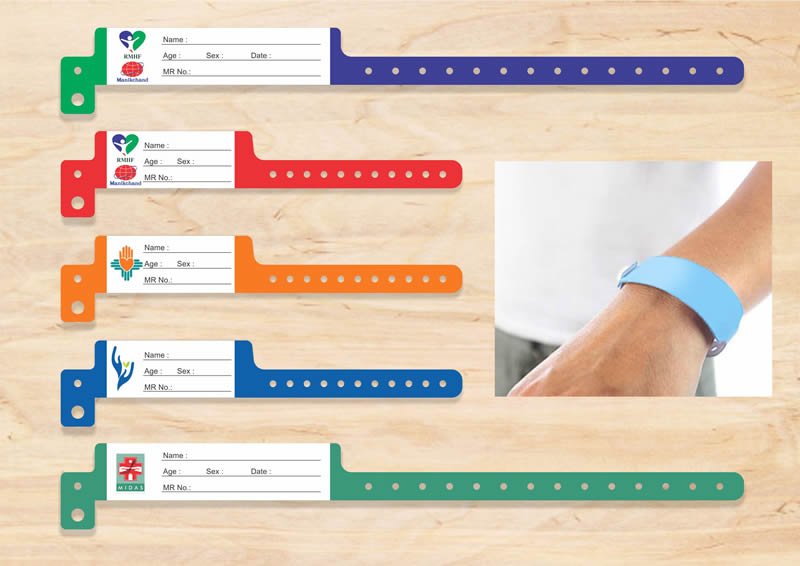The Significance of Using a Patient Identification Band in Modern Medical Practices
The Significance of Using a Patient Identification Band in Modern Medical Practices
Blog Article
Checking Out the Numerous Kinds of Patient Identification Band Utilized in Medical Facilities
In the intricate globe of health care, the crucial duty of Patient Identification bands commonly goes undetected. These bands, differing from straightforward paper wristbands to innovative RFID bands, create the foundation of Patient safety methods, making sure precision in Patient Identification. Yet, the large variety of these bands, each with its special benefits and constraints, is commonly neglected. As we navigate through this subject, one may obtain insight right into the subtle intricacies and crucial relevance of such bands in medical centers.
Comprehending the Importance of Patient Identification Bands
While they might look like simple accessories, Patient Identification bands play a vital function in medical facilities. These bands work as a vital tool for verifying Patient identification, avoiding medical errors related to misidentification. The bands normally present crucial info such as the Patient's name, age, blood type, and any well-known allergies. They enable medical care experts to quickly access this vital info, thereby assisting in accurate and timely clinical treatment. Patient Identification bands also aid in improving administrative tasks, guaranteeing precise record-keeping and invoicing. In spite of their simplicity, these bands symbolize the principle of Patient safety, a cornerstone of quality health care. Without them, the danger of medical errors, and consequently, Patient injury, could dramatically raise.
Conventional Paper Wristbands: Their Usage and Limitations
Conventional paper wristbands have been a staple in Patient Identification throughout various medical centers. While their usage is widespread, they harbor certain limitations that may impact their effectiveness in Patient administration. This section will concentrate on the range of their application and the fundamental downsides connected with their use.
Paper Wristbands: Use Range
In the realm of Patient Identification, paper wristbands have actually long held a crucial function. These bands are generally used in outpatient setups, where the Patient's stay is short-lived. The wristbands consist of important details such as the Patient's name, date of birth, and a special Identification number. This easy, yet effective system, allows doctor to quickly and accurately identify clients, ensuring the appropriate therapy is provided. Paper wristbands are also used in emergency scenarios, where fast Identification is extremely important. Their use reaches occasions like blood contribution drives and mass vaccination programs, even more highlighting their adaptability. Regardless of developments in innovation, the humble paper wristband remains a affordable and reputable option for Patient Identification in numerous medical care circumstances.
Limitations of Paper Wristbands
In spite of their widespread usage, paper wristbands are not without their drawbacks. Their physical resilience is one of the significant limitations. Exposure to water, sweat, or harsh handling can provide them unreadable or also create them to degenerate. Additionally, paper wristbands usually do not have the technical capacities of even more modern-day choices, such as barcoding or RFID chips, restricting their capability to just presenting created details. The failure to upgrade or change the information on the wristband is one more shortcoming. If the details is handwritten, legibility can be endangered, leading to prospective misidentification. Paper wristbands can trigger pain or skin inflammation to some patients, specifically when put on for extended durations.
Barcoded Wristbands: Advancements in Patient Identification
While Patient Identification has actually long been an essential aspect of health care, the advent of barcoded wristbands symbolizes a substantial leap ahead. These bands leverage the simplicity of barcoding innovation, enabling Patient details to be rapidly checked and accessed. They enhance the speed and precision of Patient Identification, minimizing the risk of medical mistakes associated to misidentification. Barcoded wristbands are economical, easy to generate, and get rid of handwriting errors common with hand-operated systems. additional hints Nonetheless, they are not without restrictions. While they provide renovations over standard bands, the barcode can end up being worn or smudged, making it unreadable. In spite of this, barcoded wristbands remain an important device in modern-day health care settings, representing the junction of technology and Patient care.
Radio Regularity Identification (RFID) Bands: an Action In The Direction Of Futuristic Health Care
The development of Patient Get the facts Identification bands has produced the appearance of Superhigh frequency Identification (RFID) Bands (patient identification band). These ingenious gadgets existing vital benefits for healthcare centers, using an extra effective and technically progressed means of Patient Identification. The application of RFID in health care is a substantial step in the direction of a much more futuristic approach to Patient administration and security
Understanding RFID Bands

RFID Bands: Secret Benefits
Welcoming a future where technology and healthcare combine, superhigh frequency Identification bands use several key benefits. Primarily, these bands boost Patient security by giving precise, rapid Identification, therefore decreasing medical errors. RFID bands can save a huge amount of Patient information, including medical background and allergic reactions, making it possible for personalized care. They also enhance administrative tasks, as the automated data entrance replaces manual processes, boosting efficiency and minimizing paperwork. RFID bands offer real-time monitoring of patients, essential in high-risk environments such as surgery or intensive care. These bands are sturdy and resistant to environmental aspects, ensuring constant capability. In general, RFID look at here bands stand for a significant improvement in Patient Identification innovation, profiting both people and healthcare carriers.
Executing RFID in Medical Care
As we enter a technically advanced era, the implementation of RFID bands in health care ends up being progressively crucial. These bands supply a smooth method to track and determine individuals, guaranteeing their security and boosting efficiency in therapy procedures. RFID bands supply various advantages over traditional Identification methods. They can store a large amount of data, including the Patient's case history and treatment strategies, which can be conveniently accessed by medical care providers. This data helps physicians make educated choices pertaining to the Patient's therapy strategy. RFID bands minimize medical errors by providing exact Patient Identification, which is crucial in protecting against misdiagnosis or wrong medicine management. Hence, the implementation of RFID bands is a substantial action in the direction of boosting Patient security and healthcare delivery.

Color-Coded Wristbands: Assisting in Quick and Accurate Medical Diagnosis
In the dynamic environment of a clinical facility, color-coded wristbands have arised as vital devices for swift and precise Identification of a person's medical problem. These wristbands, worn by individuals, carry certain shades that correspond to different clinical conditions or conditions. This system is made to offer instant aesthetic cues to healthcare providers, improving Patient safety and care high quality.
Approaches for Reliable Implementation and Administration of Patient ID Bands
Attaining optimum usage of Patient Identification bands necessitates a well-structured technique for their application and administration. The initial step involves training all health and wellness employees on the relevance of correctly applying and reviewing these bands. Secondly, hospitals should standardize the usage of ID bands throughout all divisions, making sure uniformity and lowering discrepancies. Normal audits ought to be performed to validate adherence to plans and to fix any type of incongruities. Patient education is also vital; clients should comprehend the objective of the bands and the demand for their constant wear. patient identification band. Finally, it's necessary to have a backup strategy in position, such as barcode scanning or biometrics, to make certain that Patient Identification is never ever jeopardized.
Final thought
Patient Identification bands are essential in clinical facilities to make sure safety and accuracy. Efficient execution and management of these bands can considerably minimize clinical errors, increase performance, and boost overall Patient care.
These bands, varying from basic paper wristbands to innovative RFID bands, create the foundation of Patient safety procedures, making sure accuracy in Patient Identification.The advancement of Patient Identification bands has brought about the development of Radio Frequency Identification (RFID) Bands. In general, RFID bands represent a significant development in Patient Identification technology, profiting both patients and healthcare suppliers.
RFID bands minimize clinical mistakes by giving exact Patient Identification, which is crucial in preventing misdiagnosis or wrong medication management. Patient education and learning is additionally important; clients have to comprehend the objective of the bands and the need for their continuous wear.
Report this page